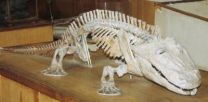(Press-News.org) PROVIDENCE, R.I. [Brown University] — Here's an anatomical packing list for making that historic trip from water to land circa 370 million years ago: Lungs? Check. Legs? Check. Patches of highly vascular bone in the skin? In a new paper, scientists propose why many of the earliest four-legged creatures that dared breathe on land carried bony skin features.
The "dermal bones" within the skin, especially the bones covering the skull roof and forming part of the shoulder girdle, had a highly complex surface of ridges and furrows called "dermal sculpture." The authors suggest that these bones served as something of a reservoir of antacids — not for the tetrapods' stomachs, but for their bodily fluids including blood. Excessive acidity would be a consequence of their seemingly inevitable struggle to get rid of carbon dioxide on land. The bone may have helped them neutralize the resulting acid buildup, as well as lactic acid from exertion. Eventually the animals would have to return to the water to rid themselves of CO2, but acid-neutralizing bone could buy them more land time as it evolved.
"The bony armor of these animals was always a mystery," said Christine Janis, professor of ecology and evolutionary biology at Brown University and lead author of the paper in Proceedings of the Royal Society B. "How would this be an advantage? Even a small amount of vascularized bone could allow you to stay out on land for a few more minutes."
Aspire to respire
There are three main ways that animals shed the CO2 exchanged for oxygen molecules in their cells. Some small creatures do it through their skin because the ratio of skin surface area to body volume is relatively high. Aquatic animals also let it out through gills or over the body surface (CO2 is more soluble in water than in air), and land animals exhale it with lungs.
The early tetrapods that Janis and her collaborators studied had problems on all three fronts. The gills of those who retained them probably worked fine, but only in the water. Meanwhile most of these animals were simply too big to solve their CO2 buildup through the skin. Finally, their lungs were not well-suited to rapid breathing because unlike humans, for example, or even reptiles, their ribs were immobile.
What's a terrestrial tetrapod tourist to do? Maybe what some modern animals including some frogs, turtles, and caimans still do when acid builds up in their body fluids: Draw on nonstructural bone or other mineral deposits to neutralize acidity. Co-author Daniel Warren, now a biology assistant professor at Saint Louis University, was a graduate student at Brown 10 years ago when he noticed that kind of activity going on in leopard frogs. His adviser, Donald Jackson, professor emeritus of medical science, has shown how dermal bone can buffer acid buildup in reptiles such as caimans and turtles. As these discoveries in modern animals have emerged, Janis has realized that the same mechanism may have been at play in early tetrapods.
Predictions and possible tests
The new paper doesn't present any direct or experimental evidence for this proposed explanation of dermal bone, but in addition to laying out the need for the tetrapods to deal with acidity and the evidence that it is a method still found in nature, the authors also note that several predictions of their proposal are typically borne out, albeit with some exceptions, in the overall fossil record.
One prediction, for example, is that primarily aquatic tetrapods would need (and therefore have) less complex (i.e., less vascularized) dermal bone than tetrapods who ventured more often onto land. For example, the mostly aquatic Whatcheeria, had very little dermal bone sculpture while the more terrestrial relative Pederpes had more. Another prediction is that tetrapods with expandable ribs would also have less dermal bone sculpture. That, too, is borne out in species of gator-like anthracosaurs, related to reptiles.
Finally the authors find evidence that the smaller, semiterrestrial species, more closely related to modern amphibians that could have used skin to eliminate CO2, also had less dermal bone sculpture than their larger relatives.
"The pattern of dermal sculpture in the various early tetrapod taxa can be shown to correspond with patterns of terrestrial versus aquatic habits, with terrestrial forms generally having more pronounced sculpture," the authors conclude. "Terrestrial forms with reduced sculpture were either small stem lissamphibians where CO2 loss could be cutaneous [through skin], or stem amniotes with morphological evidence of amniote-like costal ventilation [movable ribs]."
Ultimately, a direct test of the idea might be made feasible by identifying a chemical or structural signature in dermal bone of current animals that use it to neutralize acids with stored minerals and looking for that same signature in early tetrapod fossils, Janis said.
INFORMATION:
In addition to Janis and Warren the paper's other authors are Brown undergraduate Kelly Devlin and Florian Witzmann of the Museum of Natural History in Berlin, Germany.
The Bushnell Foundation supported the research.
Did bone ease acid for early land crawlers?
2012-04-25
ELSE PRESS RELEASES FROM THIS DATE:
Plastic Surgeon Shares Insights on Treating Depression with BOTOX
2012-04-25
Dr. Anna Petropoulos of The New England Facial & Cosmetic Surgery Center says changes she has seen in her Boston area BOTOX Cosmetic patients support the findings of a study recently published in the Journal of Psychiatric Research.
The study found a positive correlation between the use of botulinum toxin to treat the glabellar region of the face and a temporary reduction in depression.
Dr. Petropoulos says she sees similar results in some of her patients who receive treatment with BOTOX in the Boston area.
"BOTOX, which was the first FDA-approved medication ...
Scientists discover bilayer structure in efficient solar material
2012-04-25
UPTON, NY - Detailed studies of one of the best-performing organic photovoltaic materials reveal an unusual bilayer lamellar structure that may help explain the material's superior performance at converting sunlight to electricity and guide the synthesis of new materials with even better properties. The research, published in Nature Communications April 24, 2012, was conducted by scientists at the U.S. Department of Energy's (DOE) Brookhaven National Laboratory, in collaboration with researchers from Stony Brook University, Seoul National University in Korea, the Max Planck ...
Stanford study points to potential treatment for stroke
2012-04-25
STANFORD, Calif. — Stanford University School of Medicine neuroscientists have demonstrated, in a study to be published online April 24 in Stroke, that a compound mimicking a key activity of a hefty, brain-based protein is capable of increasing the generation of new nerve cells, or neurons, in the brains of mice that have had strokes. The mice also exhibited a speedier recovery of their athletic ability.
These results are promising, because the compound wasn't administered to the animals until a full three days after they had suffered strokes, said the study's senior ...
Etna Interactive Featured at Aesthetic Meeting in Vancouver
2012-04-25
Etna Interactive, a dynamic Web services firm, will be a featured exhibitor at The Aesthetic Meeting 2012 in Vancouver.
During The American Society for Aesthetic Plastic Surgery (ASAPS) meeting, May 5-8 at the Vancouver Convention Center, board-certified plastic surgeons from around the world will engage with industry-related companies about their products and services.
As a special bonus, Etna Interactive will be offering free half-hour website assessments, personalized Web marketing advice and a show guide handout with helpful tips for choosing reliable Web marketing ...
Locked down, RNA editing yields odd fly behavior
2012-04-25
PROVIDENCE, R.I. [Brown University] — Because a function of RNA is to be translated as the genetic instructions for the protein-making machinery of cells, RNA editing is the body's way of fine-tuning the proteins it produces, allowing us to adapt. The enzyme ADAR, which does this editing job in the nervous system of creatures ranging from mice to men, even edits itself. In a new study that examined the self-editing process and locked it down at two extremes in fruit flies, Brown University scientists found some surprising insights into how this "fine-tuning of the fine-tuner" ...
New Infographic Makes Caravan Insurance That Little Bit More Exciting!
2012-04-25
As part of their commitment to providing useful information in plain English, specialist niche insurance broker Cover4caravans.co.uk have added a fun and useful infographic to their website highlighting information you may not know from the caravan universe.
For example:
- it is estimated that there are a whopping 500,000 tourers on the road in the UK- with around 15-20% not insured;
- the average cost of a claim is 19.25% more than cost of a caravan insurance policy;
- the UK's most expensive static caravan in the UK is the Haulfryn Anniversary Lodge in Wales, that ...
Flu vaccination reminder via text messaging improves rate of vaccination among low-income children
2012-04-25
CHICAGO – A text messaging intervention with education-related messages sent to parents increased influenza vaccination coverage compared with usual care in a traditionally hard-to-reach, low-income, urban, minority population of children and adolescents, although coverage overall remained low, according to a study in the April 25 issue of JAMA.
"Timely vaccination is the cornerstone of influenza prevention through vaccination of susceptible populations before illness becomes epidemic in communities. The effectiveness of the influenza vaccine in children and adolescents ...
Lucky Player Wins EUR16,758 at Casino UK
2012-04-25
April has proved to be a lucky month for a Casino UK player when she hit the jackpot playing slot games. D.W. was playing the classic slots game Cash Splash when she hit a big win of EUR16,758. She is one of the many players who have struck it lucky this month.
The game Cash Splash is a 3-Reel slot with a Progressive Jackpot. This game captures the classic feel of traditional casino slots but adds a modern twist with high-quality graphics and new bonus features. This, along with many other slot games, is available to play at Casino UK. The casino boasts an impressive ...
Botox injections associated with only modest benefit for chronic migraine and daily headaches
2012-04-25
CHICAGO – Although botulinum toxin A ("Botox") injections are U.S. Food and Drug Administration approved for preventive treatment for chronic migraines, a review and analysis of previous studies finds a small to modest benefit for patients with chronic migraine headaches and chronic daily headaches, although botox injections were not associated with greater benefit than placebo for preventing episodic migraine or chronic tension-type headaches, according to an article in the April 25 issue of JAMA.
"Migraine and tension-type headaches are common. Although up to 42 percent ...
Non-Drug Treatments for ADHD by Integrative Psychiatry Experts Dr. Richard P. Brown and Dr. Patricia Gerbarg is Released on Internet Bookseller Web Sites and in Bookstores by WW Norton
2012-04-25
Richard P Brown, MD, and Patricia Gerbarg, MD, Integrative Psychiatry experts, are authors of a new book with the latest complementary treatments for ADD/ADHD entitled Non-Drug Treatments for ADHD: New Options for Kids, Adults, & Clinicians (WW Norton, 2012, hardcover, 272 pages, ISBN 978-0-393-70622-2), now in release on Internet bookseller web sites, and in US and UK bookstores.
"This book is a winner! (It is) a lively, well-researched, hugely needed book on treatments for ADHD that do not involve the use of medication. In no way anti-medication, it addresses ...


